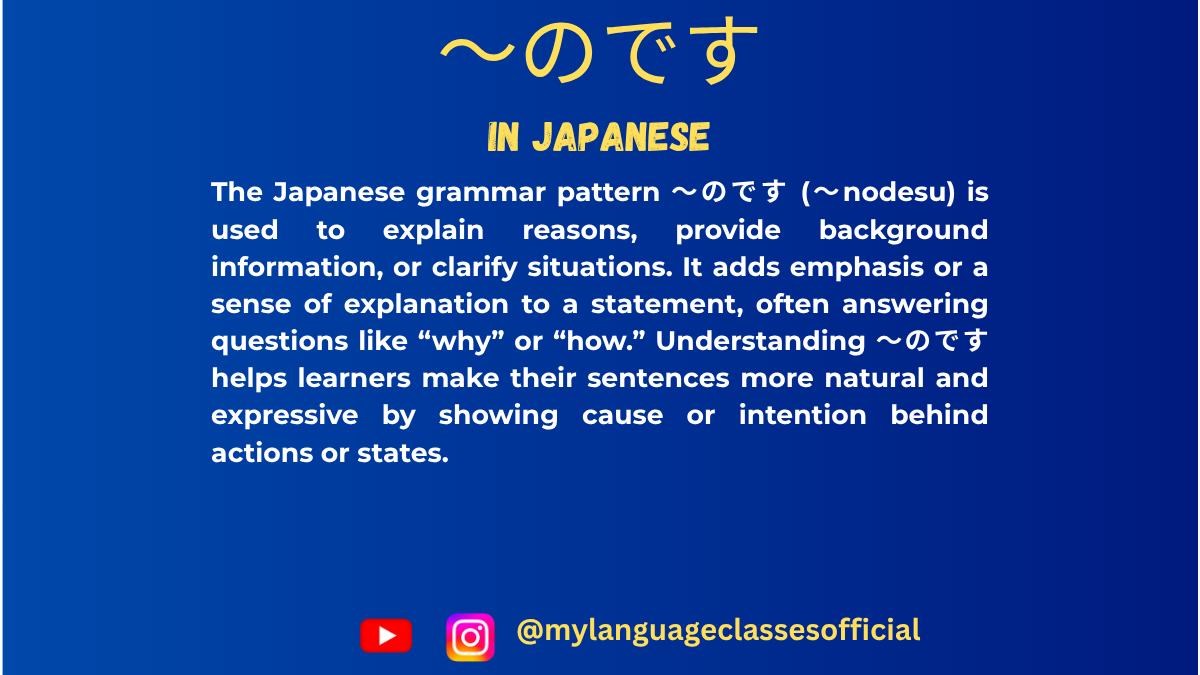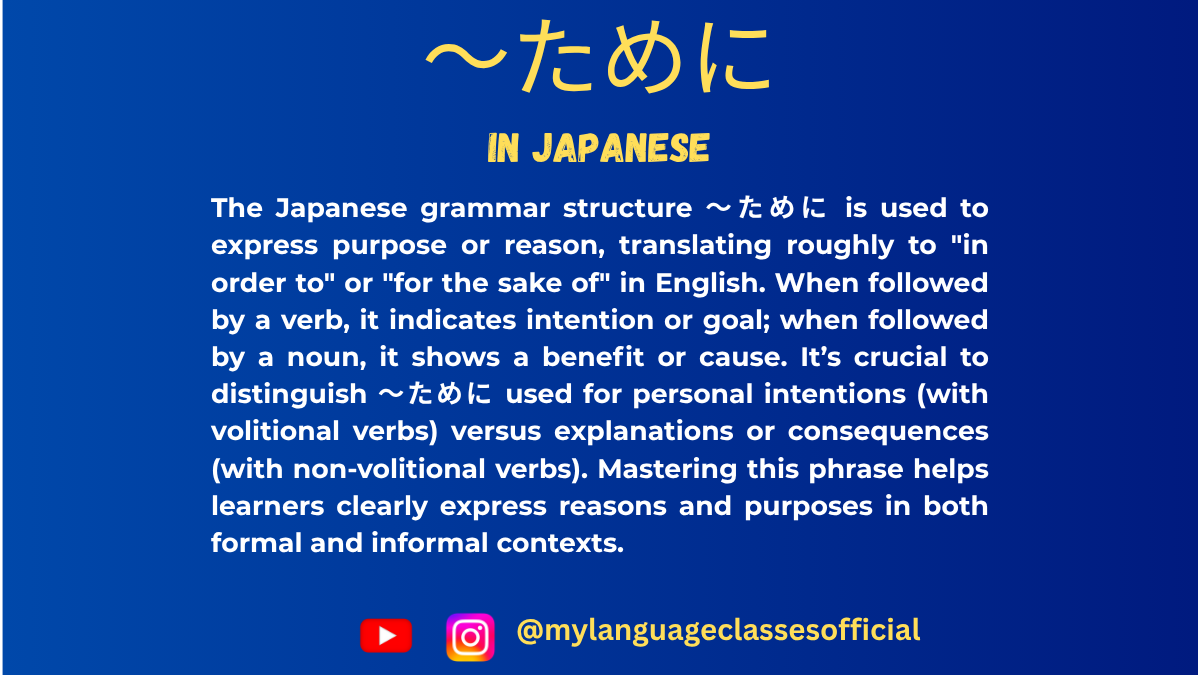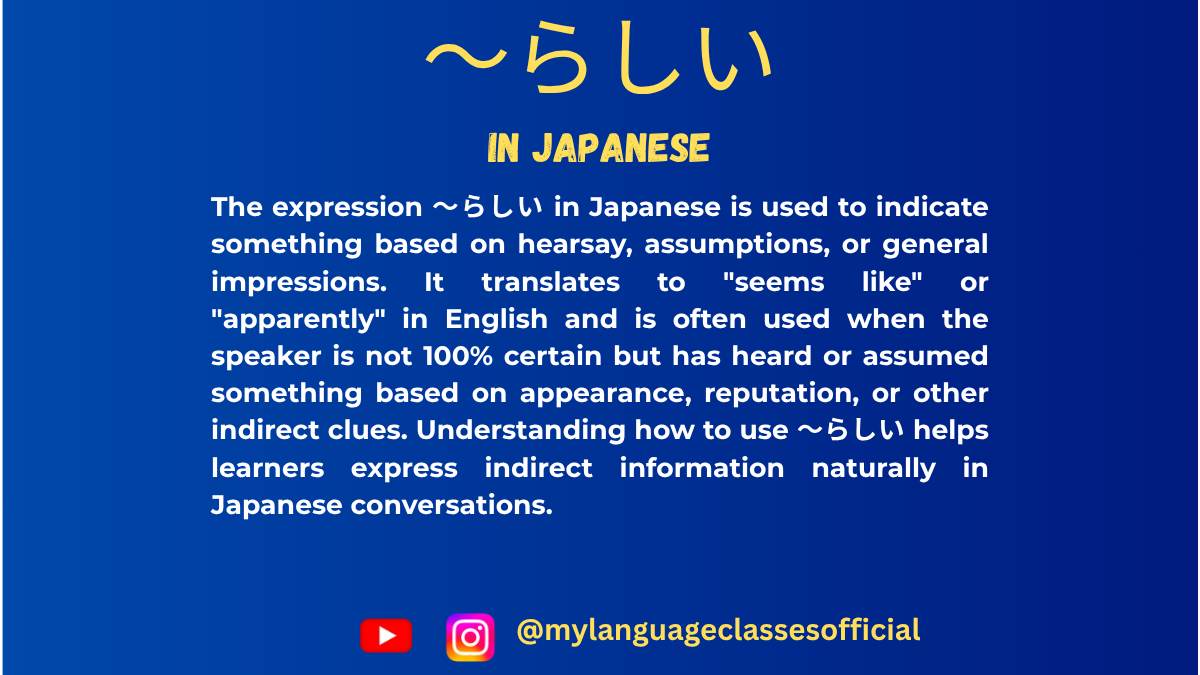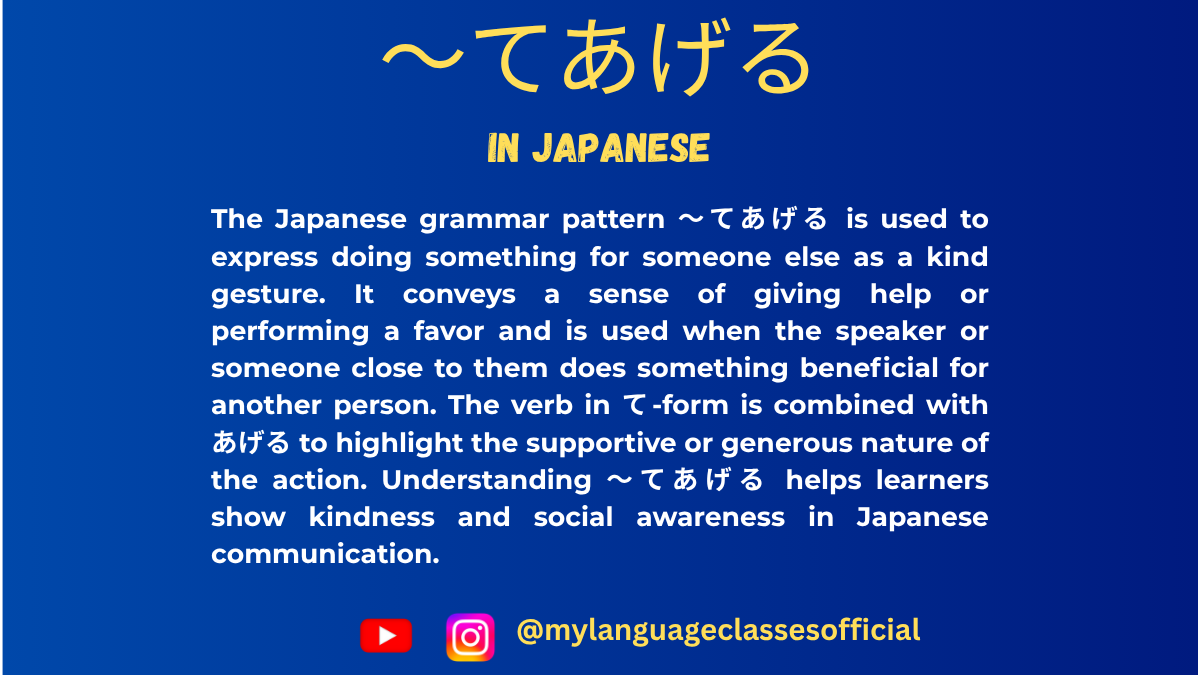Your cart is currently empty!
Tag: Japanese speaking tips
-

Understanding 〜のですin Japanese | My Language Classes
Understanding 〜のです in Japanese
The 〜のです (or its casual form 〜んです) is a grammatical structure in Japanese used to give explanations, seek clarifications, or express emotions. It adds a sense of reasoning to a statement and is often used in both spoken and written Japanese.
Formation of 〜のです
1. Formation with Verbs
- Affirmative (Present/Future):
- Dictionary form + のです / んです
- Example: 食べるのです (taberu no desu)
- Negative (Present/Future):
- ない-form + のです / んです
- Example: 食べないのです (tabenai no desu)
- Past Affirmative:
- た-form + のです / んです
- Example: 食べたのです (tabeta no desu)
- Past Negative:
- なかった-form + のです / んです
- Example: 食べなかったのです (tabenakatta no desu)
2. Formation with Nouns
- Affirmative:
- Noun + なのです / なんです (casual)
- Example: 学生なのです (gakusei nano desu)
- Negative:
- Noun + ではないのです / じゃないんです (casual)
- Example: 学生ではないのです (gakusei dewa nai no desu)
3. Formation with Adjectives
- i-Adjectives:
- そのまま + のです / んです
- Example: うれしいのです (ureshii no desu)
- Negative: うれしくないのです (ureshikunai no desu)
- na-Adjectives:
- な + のです / んです
- Example: 静かなのです (shizuka nano desu)
- Negative: 静かではないのです (shizuka dewa nai no desu)
Usage of 〜のです
The 〜のです form is used in various situations. Below are the key contexts in which it is used:
1. Providing an Explanation
This form is often used to explain reasons behind actions or situations.
- Example: どうして遅れたのですか? (Why were you late?)
- Example: 雨が降っていたのです。(It was raining.)
2. Seeking Clarification or Confirmation
When you are trying to confirm or seek clarification about something.
- Example: その本はあなたのものなのですか? (Is that book yours?)
3. Expressing a Justification
To justify an action or event.
- Example: 宿題が多かったのです。(I had a lot of homework.)
4. Making a Statement More Emphatic
Using のです makes the statement more formal or assertive.
- Example: 私が行くのです。(I will go.)
5. Stating a Fact with Emphasis
- Example: これはとても大切なのです。(This is very important.)
Other Usage of 〜のです
Situations where 〜のです is used
- Giving explanations or reasons
- Asking for explanations or clarifications
- Expressing emotions such as surprise or concern
- Emphasizing a statement
- Giving background information
- Making an indirect request
- Softening a statement
- Seeking confirmation
- Expressing curiosity
- Describing an unusual situation
List of Verbs with their 〜のです Form
Verb (Dictionary Form) 〜のです Form Example Sentence 1 Romaji Meaning Example Sentence 2 Romaji Meaning 食べる (taberu) 食べるのです これは毎日食べるのです。 Kore wa mainichi taberu no desu. I eat this every day. 彼は魚を食べるのですか? Kare wa sakana o taberu no desu ka? Does he eat fish? 行く (iku) 行くのです 学校へ行くのです。 Gakkou e iku no desu. I am going to school. どこへ行くのですか? Doko e iku no desu ka? Where are you going? 来る (kuru) 来るのです 明日、彼が来るのです。 Ashita, kare ga kuru no desu. He is coming tomorrow. どうして来るのですか? Doushite kuru no desu ka? Why is he coming? 見る (miru) 見るのです 彼はテレビを見るのです。 Kare wa terebi o miru no desu. He watches TV. 何を見ているのですか? Nani o mite iru no desu ka? What are you watching? 書く (kaku) 書くのです 彼女は日記を書くのです。 Kanojo wa nikki o kaku no desu. She writes a diary. 何を書いているのですか? Nani o kaite iru no desu ka? What are you writing? 話す (hanasu) 話すのです 先生は日本語を話すのです。 Sensei wa nihongo o hanasu no desu. The teacher speaks Japanese. 彼と何を話していたのですか? Kare to nani o hanashite ita no desu ka? What were you talking about with him? 買う (kau) 買うのです 私は新しい車を買うのです。 Watashi wa atarashii kuruma o kau no desu. I will buy a new car. 何を買ったのですか? Nani o katta no desu ka? What did you buy? 泳ぐ (oyogu) 泳ぐのです 彼は毎朝泳ぐのです。 Kare wa maiasa oyogu no desu. He swims every morning. どこで泳ぐのですか? Doko de oyogu no desu ka? Where do you swim? 勉強する (benkyou suru) 勉強するのです 私は毎日日本語を勉強するのです。 Watashi wa mainichi nihongo o benkyou suru no desu. I study Japanese every day. 何を勉強しているのですか? Nani o benkyou shite iru no desu ka? What are you studying? 働く (hataraku) 働くのです 彼は銀行で働くのです。 Kare wa ginkou de hataraku no desu. He works at a bank. どこで働いているのですか? Doko de hataraite iru no desu ka? Where do you work? 走る (hashiru) 走るのです 彼は毎朝公園で走るのです。 Kare wa maiasa kouen de hashiru no desu. He runs in the park every morning. どのくらい走るのですか? Dono kurai hashiru no desu ka? How far do you run? 歌う (utau) 歌うのです 彼女はとても上手に歌うのです。 Kanojo wa totemo jouzu ni utau no desu. She sings very well. どんな歌を歌うのですか? Donna uta o utau no desu ka? What kind of songs do you sing? 覚える (oboeru) 覚えるのです 私は新しい単語を覚えるのです。 Watashi wa atarashii tango o oboeru no desu. I memorize new words. どうやって覚えるのですか? Dou yatte oboeru no desu ka? How do you memorize them? 遊ぶ (asobu) 遊ぶのです 子供たちは公園で遊ぶのです。 Kodomotachi wa kouen de asobu no desu. The children play in the park. どこで遊ぶのですか? Doko de asobu no desu ka? Where do they play?
More Example Sentences
- 明日はテストがあるのです。
Ashita wa tesuto ga aru no desu.
(There is a test tomorrow.) - 彼女は病気なのです。
Kanojo wa byouki na no desu.
(She is sick.) - この本は大切なのです。
Kono hon wa taisetsu na no desu.
(This book is important.)
4. 彼は昨日学校を休んだのです。
Kare wa kinō gakkō o yasunda no desu.
(He was absent from school yesterday.)5. どうしてそんなに疲れているのですか?
Dōshite sonna ni tsukarete iru no desu ka?
(Why are you so tired?)6.この時計は祖父からもらったのです。
Kono tokei wa sofu kara moratta no desu.
(I received this watch from my grandfather.)7. 彼女は日本に行くのです。
Kanojo wa Nihon ni iku no desu.
(She is going to Japan.)8. 電車が遅れたのです。
Densha ga okureta no desu.
(The train was delayed.)9.その映画はとても感動的だったのです。
Sono eiga wa totemo kandō-teki datta no desu.
(That movie was very emotional.)10.雨が降っていたのです。
Ame ga futte ita no desu.
(It was raining.)
Things to Keep in Mind
- のです is often shortened to んです in spoken language.
- It is more polite and formal than a direct statement.
- Used in interrogative sentences to seek more information.
- Often used in written explanations and discussions.
Fill in the Blanks
- なぜ学校を休んだ____?
- 彼女は来ない____。
- 私は先生に質問した____。
- どうして泣いている____か?
- 彼は何も言わなかった____。
- あなたが怒っているのは知っている____。
- 昨日、帰りが遅くなった____。
- この本を読んだことがある____か?
- 今日は早く寝たほうがいい____よ。
- 彼がそんなことをするはずがない____。
Conclusion
The 〜のです form is an essential grammar structure that allows Japanese speakers to explain reasons, seek clarifications, and emphasize statements naturally. Mastering its usage will significantly improve your fluency in Japanese communication. Practice using のです in different situations, and you’ll soon find yourself speaking more like a native!
If you enjoyed this lesson, be sure to check out more posts like this on my blog at My Language Classes. Don’t forget to subscribe my YouTube channel and follow me on Instagram for the latest language learning tips and lessons. Leave a comment below to share your thoughts, or ask any questions you have about nouns.
Happy learning! 😊
- Affirmative (Present/Future):
-

Using 〜ために in Japanese | My Language Classes
Understanding 〜ために in Japanese
In Japanese, “〜ために” (tame ni) is a highly versatile grammatical structure used to indicate purpose, reason, or benefit. Understanding its different meanings and contexts is crucial for mastering the Japanese language.
This article will explain all the possible uses of “ために” along with example sentences and a list of situations where it is commonly used.
**1. Expressing Purpose (目的)
The most common use of “ために” is to express purpose or intention. In this case, it is used with dictionary form verbs or nouns.**
Structure:
- Verb (dictionary form) + ために
- Noun + の + ために
Examples:
- 体重を減らすために歩いています。 (I walk in order to lose weight.)
- 簡単な日本語を勉強するためにこのアプリを使う。 (I use this app to study simple Japanese.)
- 健康のために毎日ヨガをしています。 (For my health, I do yoga every day.)
Note:
- “ために” is used for intentional actions performed by someone with a goal in mind.
2. Expressing Reason or Cause (原因)
“ために” can also be used to express a reason or cause for a particular event, similar to “because of” in English.
Structure:
- Verb (plain past form) + ために
- Noun + の + ために
Examples:
- 天気が悪かったためにゲームが中止された。 (Because of bad weather, the game was canceled.)
- 病気のために休んだ。 (I took a break because of illness.)
- 仕事が大変だったためにとても疲れています。 (Because work was difficult, I am very tired.)
Note:
- In this case, the outcome is not controlled by the speaker and is often negative.
3. Expressing Benefit or Effect (利益)
Another meaning of “ために” is to indicate the benefit or positive effect of something.
Structure:
- Noun + の + ために
Examples:
- 子供のために私たちは最良の教育を提供したい。 (For the benefit of children, we want to provide the best education.)
- 世界のために安全な環境を作りましょう。 (For the benefit of the world, let’s create a safe environment.)
Note:
- This use of “ために” is often found in formal speech, policies, and slogans.
4. “ために” vs. “ように” (Comparison)
Both “ために” and “ように” express purpose, but they have different uses:
Phrase Used with Meaning ために Dictionary-form verbs (intentional) Purpose (the subject can control the action) ように Potential-form verbs or non-intentional actions Purpose (the subject cannot directly control the action) Examples:
- ために: 体重を減らすために歩いています。 (I walk in order to lose weight.)
- ように: 日本語を話せるように勉強している。 (I study so that I can speak Japanese.)
Key difference: “ために” is used when the subject can control the outcome, while “ように” is used for situations where the outcome depends on ability or an external factor.
Situations Where 〜ために is Used
Situation Example Expressing Purpose 旅行するためにお金を貯めています。 Expressing Reason 天気が悪かったためにコンサートが中止された。 Expressing Benefit 社会のために活動しています。
Conclusion
The structure “ために” is an essential part of Japanese grammar, used to express purpose, reason, and benefit. Mastering its different uses will greatly improve your ability to form complex and meaningful sentences in Japanese.
Understanding the differences between “ために” and similar expressions like “ように” will help you sound more natural in Japanese conversations. Keep practicing and using “ために” in different contexts!
If you enjoyed this lesson, be sure to check out more posts like this on my blog at My Language Classes. Don’t forget to subscribe my YouTube channel and follow me on Instagram for the latest language learning tips and lessons. Leave a comment below to share your thoughts, or ask any questions you have about nouns.
Happy learning! 😊
-

Understanding 〜らしい in Japanese | My Language Classes
Understanding 〜らしい in Japanese
When learning Japanese, one of the essential expressions to understand is 〜らしい. This suffix plays a vital role in expressing assumptions, hearsay, characteristics, and appropriateness. In this blog post, we will explore all possible usages of 〜らしい, providing clear explanations and examples.
1. Expressing Hearsay or Second-hand Information
One of the most common uses of 〜らしい is to indicate information that the speaker has heard from someone else but has not personally verified.
Structure:
Verb (Plain Form) + らしい
い-adjective (Plain Form) + らしい
な-adjective + らしい
Noun + らしいExamples:
- そのレストランは美味しいらしいよ。
(I heard that restaurant is delicious.) - たろうは今日休むらしい。
(I heard that Tarou is taking the day off today.) - この映画はめちゃくちゃ面白いらしい。
(I heard that this movie is really interesting.)
Usage Note:
Compared to そうだ, which is also used for hearsay, らしい implies that the information is based on indirect sources rather than direct observation.
2. Expressing Assumptions or Inferences
Another way to use 〜らしい is when making an assumption based on evidence.
Examples:
- たくさんの人が黒い服を着ている。 お蔵式があったらしい。
(Many people are wearing black clothes. It looks like there was a funeral.) - あの子はプロ野球選手の子どもらしい。
(That child seems to be the son of a professional baseball player.)
Usage Note:
This is different from ようだ, which is used for assumptions based on visual evidence, whereas らしい is based on reasoning or known facts.
3. Expressing Typical Characteristics
〜らしい can also be used to describe something that has the typical characteristics of a person, thing, or behavior.
Examples:
- このラーメンは日本らしい味だね。
(This ramen has a very “Japanese” flavor.) - かれは仕事に小さいことまで注意を払う。真面目らしい人だ。
(He pays attention to small details in his work. He is a serious person.) - 她はいつも元気で、すごく子どもらしい。
(She is always energetic, very much like a child.)
Usage Note:
This usage expresses the “essence” of something or someone. It is similar to みたい but is more about inherent qualities rather than just resemblance.
4. Expressing Suitability or Appropriateness
In some cases, 〜らしい can be used to indicate something that fits a certain expectation or role.
Examples:
- 日本らしいけしきゃんの誕生日プレゼントを買いたい。
(I want to buy a birthday present that is “Japanese-like”.) - 少年らしい仕事を求めている。
(Looking for work suitable for young people.)
Usage Note:
This is closely related to the “typical characteristics” meaning but emphasizes suitability rather than mere resemblance.
Situations Where 〜らしい is Used
Below is a list of common situations where 〜らしい is applicable:
- Hearsay – When conveying information heard from others.
- Inference – When making an assumption based on indirect evidence.
- Typical Characteristics – When describing something as having the essence of a person, thing, or behavior.
- Suitability – When expressing something as being appropriate for a certain role or image.
- Rumors – When talking about unverified rumors or gossip.
Final Thoughts
Mastering 〜らしい is essential for expressing assumptions, typicality, and hearsay in Japanese. While it might seem tricky at first, practicing with real-life examples and distinguishing it from similar expressions like そうだ and ようだ will help you use it naturally.
By understanding these nuances, you’ll be able to sound more fluent and natural in your Japanese conversations. Keep practicing, and don’t hesitate to use 〜らしい in different situations!
If you enjoyed this lesson, be sure to check out more posts like this on my blog at My Language Classes. Don’t forget to subscribe my YouTube channel and follow me on Instagram for the latest language learning tips and lessons. Leave a comment below to share your thoughts, or ask any questions you have about nouns.
Happy learning! 😊
- そのレストランは美味しいらしいよ。
-

How to Use 〜てあげる | My Language Classes
〜てあげる: To Give (an Action) in Japanese
When learning Japanese, you will often encounter the phrase 〜てあげる (te ageru), which means “to give (an action).” This phrase is used when the speaker or someone performs a beneficial action for another person. The nuance of 〜てあげる is that the action is done out of kindness or generosity.
How to Use 〜てあげる
The structure is simple:
[Person] は [Recipient] に [Action in 〜て-form] + あげる
Example:
- わたしは ともだち に 本を 貸してあげました。
(Watashi wa tomodachi ni hon o kashite agemashita.)
→ I lent a book to my friend (as a favor).
Different Forms of 〜てあげる
The verb あげる can be conjugated into different forms to match the politeness level:
Form Usage 〜てあげる Casual/plain form 〜てあげます Polite form 〜てあげて Te-form for requests 〜てあげない Negative form (not doing the action) 〜てあげなかった Past negative form Situations Where 〜てあげる Is Used
1. Doing Something Nice for Someone Else
- わたしは ちょうとせんせい に にもつを 持ってあげました。
(Watashi wa chouto sensei ni nimotsu o motte agemashita.)
→ I carried the teacher’s luggage for them.
2. Helping Someone
- おとうさんは ぼくに 自転車の修理を してあげた。
(Otousan wa boku ni jitensha no shuuri o shite ageta.)
→ Dad fixed my bicycle for me.
3. Giving Advice or Instruction
- わたしは ともだち に 日本語 を 教えてあげる。
(Watashi wa tomodachi ni nihongo o oshiete ageru.)
→ I will teach my friend Japanese.
4. Buying Something for Someone
- おかあさんは いもうと に 花を 買ってあげました。
(Okaasan wa imouto ni hana o katte agemashita.)
→ Mom bought flowers for my little sister.
5. Making a Favorable Gesture
- 私は 友達 に コーヒーを 作ってあげました。
(Watashi wa tomodachi ni koohii o tsukutte agemashita.)
→ I made coffee for my friend.
6. Expressing Kindness in a Relationship
- けんたろうは かのじょに マッサージを かいてあげた。
(Kentaro wa kanojo ni massaaji o kaite ageta.)
→ Kentaro gave his girlfriend a massage.
7. Helping Children or Animals
- おねえさんは 犬 に 食べ物 を あげてあげた。
(Oneesan wa inu ni tabemono o agete ageta.)
→ The older sister gave food to the dog.
Things to Remember About 〜てあげる
- Used when the action is beneficial: You should only use 〜てあげる when the action is helpful or kind.
- Do not use for superiors: Avoid using 〜てあげる when speaking about actions for a superior (e.g., boss, teacher) as it may sound rude. Instead, use 〜てさしあげる.
- Casual tone: This phrase is often used in informal or everyday conversations rather than in formal writing.
Summary Table: When to Use 〜てあげる
Situation Example Helping a friend はさみを 買ってあげた。 (Bought scissors for them.) Teaching someone えいご を 教えてあげる。 (Teach English to them.) Doing a favor 部屋を 掃除してあげる。 (Clean the room for them.) Helping animals 犬 に 飯 を あげてあげる。 (Give food to a dog.) By mastering 〜てあげる, you can express kindness and generosity in Japanese naturally! Practice using it in real conversations to make your speech sound more fluent and native-like.
Do you have any questions about 〜てあげる? Let me know in the comments!
If you enjoyed this lesson, be sure to check out more posts like this on my blog at My Language Classes. Don’t forget to subscribe my YouTube channel and follow me on Instagram for the latest language learning tips and lessons. Leave a comment below to share your thoughts, or ask any questions you have about nouns.
Happy learning! 😊
- わたしは ともだち に 本を 貸してあげました。
